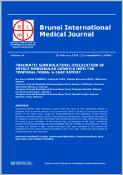Options
Traumatic superolateral dislocation of intact mandibular condyle into the temporal fossa: A case report
Journal
Brunei International Medical Journal
Date Issued
2018
Author(s)
Norhayati OMAR
Mohd Nury YUSOFF
Abstract
Temporomandibular joint dislocation occurs when the head of the mandibular condyle is dislodged from its normal position in the glenoid fossa which is located in the squamo-temporal portion of the cranial base. Causes of temporomandibular joint dislocation include trauma, iatrogenic, connective tissue disorder, drug induced or spontaneous. Superolateral dislocation of the condyle is uncommon and it has been first described by Allen and Young where they reported five cases of such dislocation. In this present case the dislocation of the intact mandibular condyle into the temporal fossa was not associated with any mandible or facial fractures, making it unique and difficult to treat. Several techniques have been described in the literature for management of this type of condylar dislocation, but in this case, coronal flap was choosen as surgical access for open reduction. � 2010 Ministry of Health.
File(s)
Loading...
Name
Traumatic superolateral dislocation of intact mandibular condyle into the temporal fossa_ A case report.pdf
Size
517.84 KB
Format
Adobe PDF
Checksum
(MD5):e160e40a1add407f3255d34339c88d1b